Global Medical Image Management Market Size (2024-2034): By Product Type, By Deployment Mode, By Modality, By Application, By End User, By Region, Comparative Analysis and Trends
- Industry: Healthcare
- Report ID: TNR-110-1074
- Number of Pages: 420
- Table/Charts : Yes
- April, 2024
- Base Year : 2024
- No. of Companies : 10+
- No. of Countries : 29
- Views : 10234
- Covid Impact Covered: Yes
- War Impact Covered: Yes
- Formats : PDF, Excel, PPT
In Terms of Revenue, Global Medical Image Management Market was Worth US$ 3.5 Bn in 2023 and is Anticipated To Witness a CAGR of 8.1% During 2024 – 2034.
The global market is experiencing robust growth, driven by technological advancements and the increasing adoption of medical imaging devices. This market encompasses solutions for the storage, retrieval, sharing, and analysis of medical images, including radiology, pathology, and cardiology images.
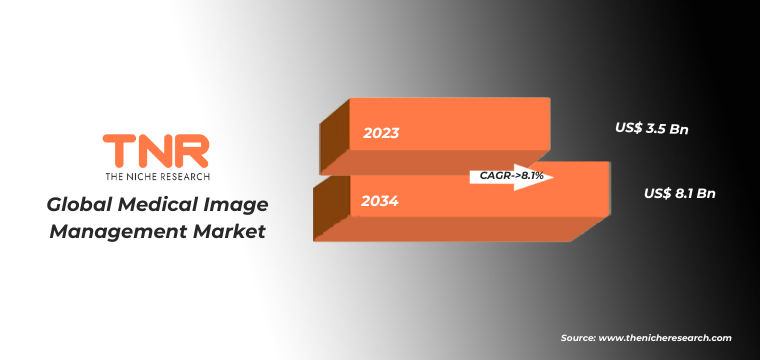
Factors such as the growing prevalence of chronic diseases, rising demand for efficient healthcare delivery, and the need for integrated healthcare IT systems contribute to the market’s expansion. Additionally, the transition towards cloud-based solutions and the integration of artificial intelligence (AI) for image analysis are further propelling market growth, with key players continually innovating to meet evolving healthcare demands.
Global Medical Image Management Market Growth Drivers
Technological advancements in imaging devices, rising demand for efficient healthcare delivery, increasing prevalence of chronic diseases, adoption of integrated healthcare IT systems, transition to cloud-based solutions, and integration of artificial intelligence for image analysis are some of the factors accelerating the market growth.
Global Medical Image Management Market Restraints
Concerns regarding data security and privacy, regulatory compliance issues, interoperability challenges between different systems, high implementation costs for advanced solutions, and resistance to adopting new technologies among some healthcare providers are the factors hindering the market’s growth to some extent.
Global Medical Image Management Market Opportunities
Opportunities abound in the global medical image management market, including the increasing demand for telemedicine and remote patient monitoring solutions, expanding applications of artificial intelligence and machine learning in medical imaging, growing investments in healthcare infrastructure in emerging economies, and the rising focus on precision medicine and personalized healthcare approaches.
Global Medical Image Management Market: Segmental Insights
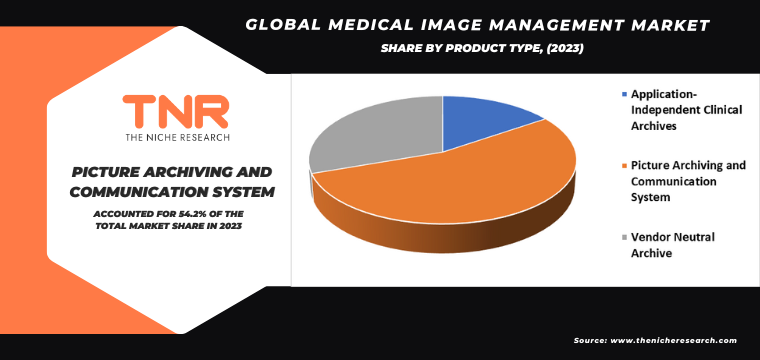
By Product Type
- Application-Independent Clinical Archives
- Picture Archiving and Communication System
- Vendor Neutral Archive
Picture archiving and communication system (PACS) asserted its dominance in 2023, capturing a substantial 54.2% revenue share. Its success stems from streamlined digital image management, facilitating efficient storage, retrieval, and sharing of medical images, thus meeting the evolving demands of healthcare providers and patients alike.
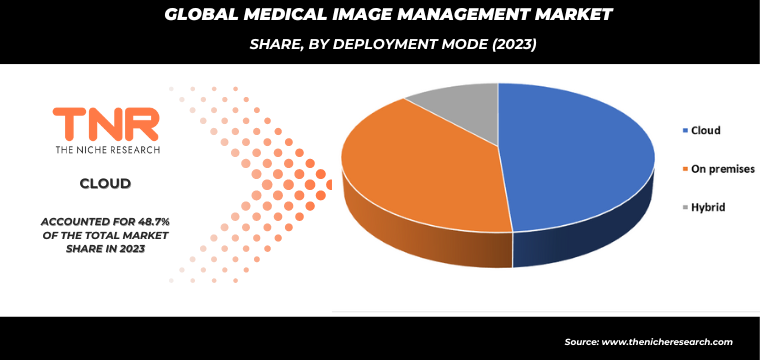
By Deployment Mode
- Cloud
- On premises
- Hybrid
The cloud deployment mode emerged as the dominant prime in the global market, exhibiting a remarkable CAGR of 8.4%. This trend is fuelled by the scalability, accessibility, and cost-effectiveness of cloud-based solutions, meeting the evolving needs of healthcare organizations worldwide.
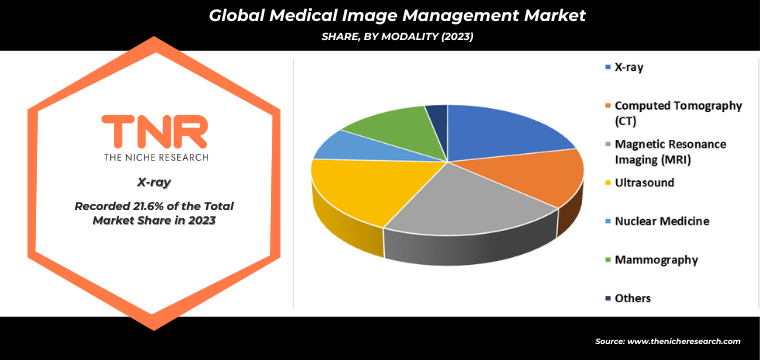
By Modality
- X-ray
- Computed Tomography (CT)
- Magnetic Resonance Imaging (MRI)
- Ultrasound
- Nuclear Medicine
- Mammography
- Others
Magnetic resonance imaging (MRI) is poised to gain popularity in the coming years due to its non-invasive nature, superior soft tissue visualization, and expanding applications in various medical fields. With advancements enhancing its accuracy and efficiency, MRI is increasingly favoured for diagnostic imaging procedures.
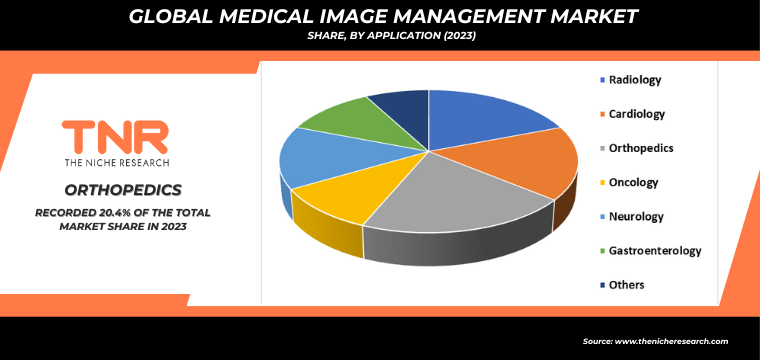
By Application
- Radiology
- Cardiology
- Orthopedics
- Oncology
- Neurology
- Gastroenterology
- Others
Orthopaedics secured dominance in 2023, claiming a significant revenue share of 20.4% due to increasing musculoskeletal disorders, rising aging population, and advancements in orthopaedic treatments and surgeries. These factors drove demand for orthopaedic devices and implants, boosting the market’s growth.
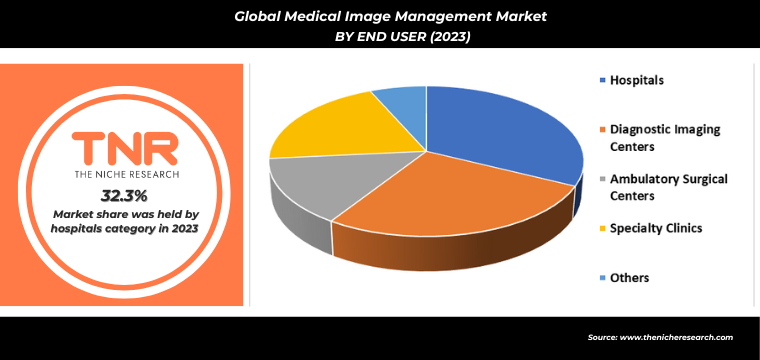
By End User
- Hospitals
- Diagnostic Imaging Centers
- Ambulatory Surgical Centers
- Specialty Clinics
- Others
Hospitals led the market with the largest share of 32.3% in 2023, bolstered by their role as primary healthcare providers and their extensive use of medical imaging technologies for diagnosis, treatment, and patient care, thus contributing to their significant market presence.
By Region
- North America (U.S., Canada, Mexico, Rest of North America)
- Europe (France, The UK, Spain, Germany, Italy, Nordic Countries (Denmark, Finland, Iceland, Sweden, Norway), Benelux Union (Belgium, The Netherlands, Luxembourg), Rest of Europe)
- Asia Pacific (China, Japan, India, New Zealand, Australia, South Korea, Southeast Asia (Indonesia, Thailand, Malaysia, Singapore, Rest of Southeast Asia), Rest of Asia Pacific)
- Middle East & Africa (Saudi Arabia, UAE, Egypt, Kuwait, South Africa, Rest of Middle East & Africa)
- Latin America (Brazil, Argentina, Rest of Latin America)
Europe emerges as the second-leading region in the global market, boasting a commendable CAGR of 7.8%. This growth is propelled by factors such as increasing investments in healthcare infrastructure, technological advancements, and government initiatives to enhance healthcare access and quality across the region.
Report Layout
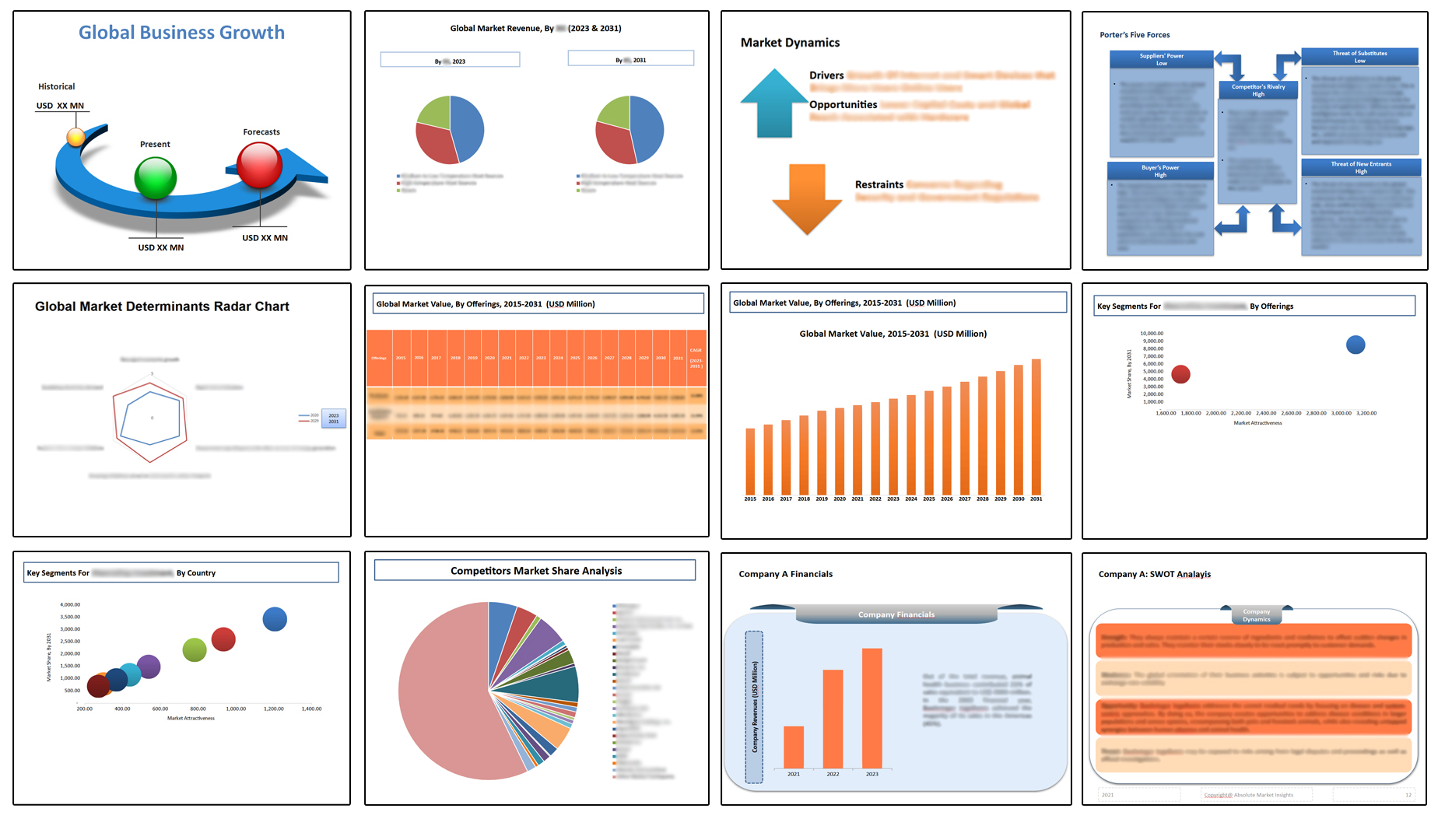
Key Market Players
- Agfa-Gevaert Group
- BridgeHead Software Ltd.
- Change Healthcare Inc.
- FUJIFILM Holdings Corporation
- GE HealthCare
- Hyland Software, Inc.
- IBM
- INFINITT Healthcare Co., Ltd.
- Koninklijke Philips N.V.
- Mach7 Technologies
- Novarad Corporation
- Sectra AB
- Siemens Healthineers AG
- Other Industry Participants
Key Development
- In October 2022, Google Cloud introduced a range of medical imaging tools aimed at facilitating quicker and more accurate image diagnosis, improving efficiency for healthcare professionals, and enhancing patient care outcomes. These tools are poised to advance the development of artificial intelligence in imaging and comprise Imaging Storage, Imaging Lab, Imaging Datasets & Dashboards, and Imaging AI Pipelines.
- In June 2022, Bayer unveiled Calantic Digital Solutions, a novel cloud-based platform offering access to digital applications for medical imaging, featuring artificial intelligence tools. This platform includes functionalities to expedite critical patient evaluations, refine lesion diagnosis, and automate various tasks, underscoring Bayer’s commitment to innovating in healthcare technology.
Global Medical Image Management Market Report Coverage
| Report Specifications | Details |
| Market Revenue in 2023 | US$ 3.5 Bn |
| Market Size Forecast by 2034 | US$ 8.1 Bn |
| Growth Rate (CAGR) | 8.1% |
| Historic Data | 2016 – 2022 |
| Base Year for Estimation | 2023 |
| Forecast Period | 2024 – 2034 |
| Report Inclusions | Market Size & Estimates, Market Dynamics, Competitive Scenario, Trends, Growth Factors, Market Determinants, Key Investment Segmentation, Product/Service/Solutions Benchmarking |
| Segments Covered | By Product Type, By Deployment Mode, By Modality, By Application, By End User |
| Regions Covered | North America, Europe, Asia Pacific, Middle East & Africa, Latin America |
| Countries Covered | U.S., Canada, Mexico, Rest of North America, France, The UK, Spain, Germany, Italy, Nordic Countries (Denmark, Finland, Iceland, Sweden, Norway), Benelux Union (Belgium, The Netherlands, Luxembourg), Rest of Europe, China, Japan, India, New Zealand, Australia, South Korea, Southeast Asia (Indonesia, Thailand, Malaysia, Singapore, Rest of Southeast Asia), Rest of Asia Pacific, Saudi Arabia, UAE, Egypt, Kuwait, South Africa, Rest of Middle East & Africa, Brazil, Argentina, Rest of Latin America |
| Key Players | Agfa-Gevaert Group, BridgeHead Software Ltd., Change Healthcare Inc., FUJIFILM Holdings Corporation, GE HealthCare, Hyland Software, Inc., IBM, INFINITT Healthcare Co., Ltd., Koninklijke Philips N.V., Mach7 Technologies, Novarad Corporation, Sectra AB, Siemens Healthineers AG |
| Customization Scope | Customization allows for the inclusion/modification of content pertaining to geographical regions, countries, and specific market segments. |
| Pricing & Procurement Options | Explore purchase options tailored to your specific research requirements |
| Contact Details | Consult With Our Expert
Japan (Toll-Free): +81 663-386-8111 South Korea (Toll-Free): +82-808- 703-126 Saudi Arabia (Toll-Free): +966 800-850-1643 United Kingdom: +44 753-710-5080 United States: +1 302-232-5106 E-mail: askanexpert@thenicheresearch.com
|
Table of Contents
Note: This ToC is tentative and can be changed according to the research study conducted during the course of report completion.
**Exclusive for Multi-User and Enterprise User.
Global Medical Image Management Market
By Product Type
- Application-Independent Clinical Archives
- Picture Archiving and Communication System
- Vendor Neutral Archive
By Deployment Mode
- Cloud
- On premises
- Hybrid
By Modality
- X-ray
- Computed Tomography (CT)
- Magnetic Resonance Imaging (MRI)
- Ultrasound
- Nuclear Medicine
- Mammography
- Others
By Application
- Radiology
- Cardiology
- Orthopedics
- Oncology
- Neurology
- Gastroenterology
- Others
By End User
- Hospitals
- Diagnostic Imaging Centers
- Ambulatory Surgical Centers
- Specialty Clinics
- Others
By Region
- North America (U.S., Canada, Mexico, Rest of North America)
- Europe (France, The UK, Spain, Germany, Italy, Nordic Countries (Denmark, Finland, Iceland, Sweden, Norway), Benelux Union (Belgium, The Netherlands, Luxembourg), Rest of Europe)
- Asia Pacific (China, Japan, India, New Zealand, Australia, South Korea, Southeast Asia (Indonesia, Thailand, Malaysia, Singapore, Rest of Southeast Asia), Rest of Asia Pacific)
- Middle East & Africa (Saudi Arabia, UAE, Egypt, Kuwait, South Africa, Rest of Middle East & Africa)
- Latin America (Brazil, Argentina, Rest of Latin America)
The Niche Research approach encompasses both primary and secondary research methods to provide comprehensive insights. While primary research is the cornerstone of our studies, we also incorporate secondary research sources such as company annual reports, premium industry databases, press releases, industry journals, and white papers.
Within our primary research, we actively engage with various industry stakeholders, conducting paid interviews and surveys. Our meticulous analysis extends to every market participant in major countries, allowing us to thoroughly examine their portfolios, calculate market shares, and segment revenues.
Our data collection primarily focuses on individual countries within our research scope, enabling us to estimate regional market sizes. Typically, we employ a bottom-up approach, meticulously tracking trends in different countries. We analyze growth drivers, constraints, technological innovations, and opportunities for each country, ultimately arriving at regional figures.Our process begins by examining the growth prospects of each country. Building upon these insights, we project growth and trends for the entire region. Finally, we utilize our proprietary model to refine estimations and forecasts.
Our data validation standards are integral to ensuring the reliability and accuracy of our research findings. Here’s a breakdown of our data validation processes and the stakeholders we engage with during our primary research:
- Supply Side Analysis: We initiate a supply side analysis by directly contacting market participants, through telephonic interviews and questionnaires containing both open-ended and close-ended questions. We gather information on their portfolios, segment revenues, developments, and growth strategies.
- Demand Side Analysis: To gain insights into adoption trends and consumer preferences, we reach out to target customers and users (non-vendors). This information forms a vital part of the qualitative analysis section of our reports, covering market dynamics, adoption trends, consumer behavior, spending patterns, and other related aspects.
- Consultant Insights: We tap into the expertise of our partner consultants from around the world to obtain their unique viewpoints and perspectives. Their insights contribute to a well-rounded understanding of the markets under investigation.
- In-House Validation: To ensure data accuracy and reliability, we conduct cross-validation of data points and information through our in-house team of consultants and utilize advanced data modeling tools for thorough verification.
The forecasts we provide are based on a comprehensive assessment of various factors, including:
- Market Trends and Past Performance (Last Five Years): We accurately analyze market trends and performance data from preceding five years to identify historical patterns and understand the market’s evolution.
- Historical Performance and Growth of Market Participants: We assess the historical performance and growth trajectories of key market participants. This analysis provides insights into the competitive landscape and individual company strategies.
- Market Determinants Impact Analysis (Next Eight Years): We conduct a rigorous analysis of the factors that are projected to influence the market over the next eight years. This includes assessing both internal and external determinants that can shape market dynamics.
- Drivers and Challenges for the Forecast Period:Identify the factors expected to drive market growth during the forecast period, as well as the challenges that the industry may face. This analysis aids in deriving an accurate growth rate projection.
- New Acquisitions, Collaborations, or Partnerships: We keep a close watch on any new acquisitions, collaborations, or partnerships within the industry. These developments can have a significant impact on market dynamics and competitiveness.
- Macro and Micro Factors Analysis:A thorough examination of both macro-level factors (e.g., economic trends, regulatory changes) and micro-level factors (e.g., technological advancements, consumer preferences) that may influence the market during the forecast period.
- End-User Sentiment Analysis: To understand the market from the end-user perspective, we conduct sentiment analysis. This involves assessing the sentiment, preferences, and feedback of the end-users, which can provide valuable insights into market trends.
- Perspective of Primary Participants: Insights gathered directly from primary research participants play a crucial role in shaping our forecasts. Their perspectives and experiences provide valuable qualitative data.
- Year-on-Year Growth Trend: We utilize a year-on-year growth trend based on historical market growth and expected future trends. This helps in formulating our growth projections, aligning them with the market’s historical performance.
Research process adopted by TNR involves multiple stages, including data collection, validation, quality checks, and presentation. It’s crucial that the data and information we provide add value to your existing market understanding and expertise. We have also established partnerships with business consulting, research, and survey organizations across regions and globally to collaborate on regional analysis and data validation, ensuring the highest level of accuracy and reliability in our reports.









